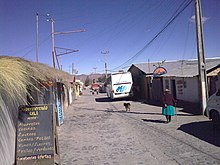Taapaca was originally considered to have been active for the last 1.5 million years during three volcanic phases. Later a fourth stage was identified, and some rocks were interpreted as pre-dating 1.5 million years ago. Eruptions at Taapaca have consisted of lava dome-forming eruptions and explosive activity with avalanches of blocks and ash, which form when lava domes collapse, as has been observed in historical time at the Soufriere Hills and Unzen volcanoes, although these events were much smaller than reconstructed episodes at Taapaca. Only one subplinian eruption has occurred on Taapaca, and tephra fallout deposits are not widespread. Eruptive activity has moved 4–5 kilometres (2.5–3.1 mi) south-southwestward over the history of Taapaca, [34] with activity centred at the top of the edifice.
Late Pleistocene to Holocene activity consisted of discrete episodes lasting about 10,000 years and separated by tens of thousands of years with no recognized activity. Aside from actual eruptions, various types of edifice collapse are recorded at Taapaca including sector collapses of segments of the volcano and mass failure of individual domes, which generated block-and-ash flows.
Phases
The oldest stage consists of Plio-Pleistocene andesite lava flows, which crop out in two sites on the northern flank and are heavily eroded and partly buried by later volcanic stages. This stage of the edifice most likely consisted of a broad stratovolcano.
Subsequently, between 1.5 and 0.5 million years ago, dacitic lava flows and lava domes constructed most of the northern and eastern flanks of the volcano. Their flow forms, such as flow ridges, are better preserved on the eastern flank, while glacial and hydrothermal alteration has occurred on the northern flank and has degraded the flow forms there. On the northern and northwestern flank, block-and-ash flows up to 13 kilometres (8.1 mi) long and with thicknesses of 20 metres (66 ft), down to less than 2 metres (6 ft 7 in) thick farther away from the volcano, have covered a surface of 110 square kilometres (42 sq mi). They often have lahars up to 5 metres (16 ft) thick cropping out in their distal regions. At this time, Taapaca likely was a large stratovolcano consisting of steep lava domes.
The third stage featured volcanic activity similar to the second stage, with its products covering 18 square kilometres (6.9 sq mi) especially in the central, eastern and southwestern parts of the edifice. Construction of another lava dome complex took place on the southern side of the volcano. Short and thick lava flows are located on the western flank, while the eastern flank features lava domes from this stage, one of which has a "pancake"-like appearance. Two alignments of domes date back to this time, one on the southern and the other on the eastern flank, both lined up north-south. The second and probably also the third stage were subject to glacial erosion, which together with later sector collapses resulted in the removal of much of Taapaca's edifice and the exposure of the core of the volcano.
The fourth stage spans the Pleistocene and Holocene and commenced with the emplacement of the Churilinco debris avalanche, which covers a surface of 1 square kilometre (0.39 sq mi). This avalanche was formed by the collapse of the older edifice between 450,000 and 430,000 years ago; most likely the collapse took place after hydrothermal alteration had weakened the edifice. The Tajane unit was emplaced between 430,000–25,000 years ago on the south-southwestern slopes, covering an area of 30 square kilometres (12 sq mi). It consists of thick lava flows, some lava domes on the western flank, a debris avalanche on the southern flank and two fans of pyroclastic flows on the southern and southwestern flank. Between 25,000 and 9,000 years ago the Socapave unit was emplaced; it consists of more lava domes on the western margin of Taapaca and another debris avalanche, which cuts into these domes. This avalanche covers an area of 20 square kilometres (7.7 sq mi) to a distance of 10 kilometres (6.2 mi) and was apparently hot when it was emplaced. This collapse was triggered by the development of a cryptodome inside the volcano, and Putre is constructed on the avalanche deposit as well as on Tajane, Socapave and Holocene pyroclastic flows. [23] A pyroclastic eruption occurred, filling in gaps in the Socapave debris avalanche deposit and emplacing more material atop the southern fan of the Tajane unit.
While Taapaca was once considered an extinct volcano, further research has identified eruptions during the Holocene. These gave rise to the Putre unit on the southern, central and southwestern slopes of the volcano. It consists of large lava domes on the eastern side of Taapaca, smaller domes on the southern side, and a pyroclastic sequence on the southern and southwestern slopes. This sequence consists of numerous block and ash flows along with blast deposits, which contain blocks and ash. The Putre unit also encompasses a pumice flow, lahars and layers of tephra. At least three pyroclastic eruptions occurred within the last 8,000 years, while tephra falls took place between 7,000 and 2,000 years ago, possibly linked to the eruption of lava domes. The Global Volcanism Program lists eight separate eruptions of Taapaca during the Holocene, [3] with the last eruption occurring 2,300 years ago around 320 BCE ± 50 years. [3] Taapaca was reported in the early 20th century to be fumarolically active, [59] but there are no recorded historical eruptions and present day activity is reflected only by hot springs. [26]




